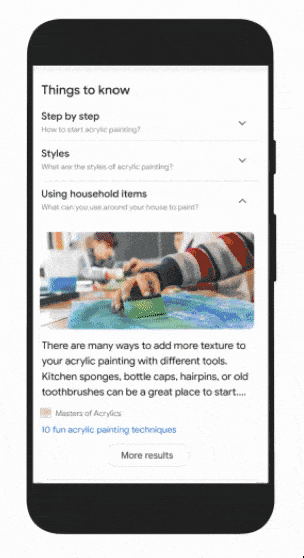Google MUM Announcement: Redesigned, Comprehensive Search
Google has certainly been on a roll when it comes to releasing updates, as shown by our past two blog posts. Despite Google being the most popular search engine, there are still shortcomings and areas of improvement. Google knows this, and last Sept. 29, they announced that we will finally be introduced to their new technology, MUM, in the next couple of months.
What is Google MUM?
Google MUM stands for Multitask Unified Model and it is their new search technology that makes search easier and better. According to Google, MUM takes search on a whole new level as it understands information in a more comprehensive way across languages and modalities such as texts, visuals, videos, and audios.
Let us say that you recently went on a trip to Osaka, Japan and decided that you wanted to head on to Tokyo. However, you aren’t sure what the differences are between the two cities and what you need to prepare for your trip. With MUM, you will get comprehensive results including but not limited to the information on Tokyo, what you may need to prepare, the best mode of transportation, places to visit in Tokyo and when, and even articles written in Japanese that are relevant to your query.
You can also take a photo of your gear and ask Google if it’s okay for your trip. Let’s say you’re heading to Tokyo in January and you’re worried it might be too cold. MUM can use your photo and query to answer your question and even give you suggestions on what kind of gear to bring and buy.
Image search and text search
With Google MUM, image search is also about to get more comprehensive as it combines text and image in one query. In one of the examples given by Google, you can open Lens and take a photo of a bike part that you don’t recognize then ask how to fix it. Google will then give you results such as videos and articles showing you the bike part and what to do to repair it.

GIF from Google
This will be much faster compared to Googling various bike parts then searching for a separate tutorial on how to repair your bike.
MUM applied to Google Search
Search is also about to be redesigned as MUM gets applied by Google. Current features such as “People also ask” and “Related searches” are about to get a whole lot more intuitive and comprehensive.
Things to know
Take a look at this example from Google:

GIF from Google
Let us say that you have been thinking of picking up a new hobby or redecorating your space, and you decide to look up acrylic painting. If you type the keyword “acrylic painting” to Search, Google MUM will show you the answers to what people tend to ask using their “Things to Know” feature.
Judging from the visuals provided in their announcement, it seems like this is an improvement of the “People also ask…” feature.
According to their announcement, MUM will at some point in the future show users other topics connected to their search that may be of interest to the users. This will help people get access to a wider range of content that they may not have thought of looking up in the first place.
Refine and broaden Search
Aside from that, Google MUM is also giving us the ability to refine and broaden our search. This looks similar to the “Related searches” feature found at the bottom of the SERPs such as this one when I look up “best leadership podcast Philippines”:

But with the upcoming feature, we don’t just get related searches, MUM will focus on our topic and actually give us results that are connected to our original query.
For example, the current “Related searches” results for acrylic painting look like this:

While the upcoming version with refine and broaden search features look like this:

Image from Google
Instead of just getting related searches, this new categorization will give users the option to delve into smaller, more specific topics or to branch out to broader ones.
Visual results page
Lastly, Search is about to get a whole lot more visual. A quick Google search of “puddle pouring ideas” as per Google’s example does not give us an image-filled SERP.

Compare this to the Google MUM version and see the difference:

GIF from Google
Images, videos, even articles containing photos will be featured on the results, making it easier for users to see what they like. According to their announcement, “This new visual results page is designed for searches that are looking for inspiration, like “Halloween decorating ideas” or “indoor vertical garden ideas,” and you can try it today.”
Testing this from the Philippines, however, shows that this update is still not applied to our SERPs. But when I changed my location to the United States using a VPN, I was able to see similarly visual-filled SERPs like the one above.
Next, Google MUM will also identify related topics in videos based on their understanding of the video content, and suggest those topics to users. The topics don’t necessarily need to be mentioned in the videos, but because of MUM, Google will be able to understand information better.
For example, if I upload a video on “How To Not Lose Your Values In Business” Google can suggest relevant searches, videos, etc. that are connected to my video. In their announcement, they mention that topics don’t necessarily need to be mentioned in the video for them to be suggested; it is Google’s understanding of the video that will generate the suggestions.
Google MUM and SEO
Now for the million-dollar question: How will this affect SEO?
I have discussed previously that this new technology will have a big effect on the SEO industry, especially as we place more and more importance on Semantic Search. According to Google, “Across all these MUM experiences, we look forward to helping people discover more web pages, videos, images and ideas that they may not have come across or otherwise searched for.” As you have seen in this post, Google’s search results are about to get even more context-dependent, with a fine-tuned understanding of what the users want and may want to see.
Image search is also more fine-tuned and the SERPs are about to get more visual. This may not affect how we do our image SEO, but this development is a good reminder that we are not supposed to leave our images unoptimized if we want them to be visible in the SERPs.
Lastly, Google MUM is about to incorporate a new way of suggesting relevant content by identifying related topics in our videos. For the users who create videos, you can opt to create a variety of content that is related to the videos you make and optimize those so that they could show in Google’s suggestions.
Key Takeaway
In the coming months we are about to see a huge change not just in the aesthetic of our SERPs but also in Google’s level of comprehension of their users’ interests and search behaviors. We may not need to do a massive overhaul of how we do our SEO today, but we can only really tell once the update is here.
Right now, what we can do is to refine our current SEO techniques especially our utilization of Semantic Search. The more we can understand our users, what they look for, and how they look for those things, the higher we can rank in the SERPs.
